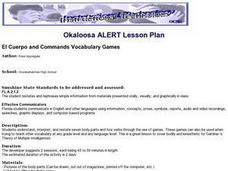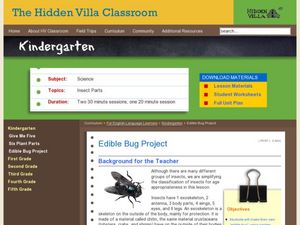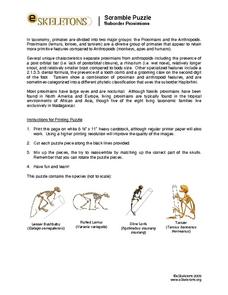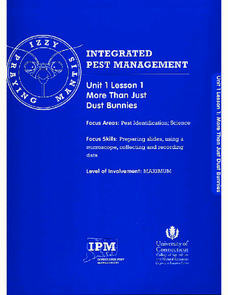US Institute of Peace
What Does It Take to Be a Peacebuilder?
Is the spirit of peacebuilding already inside you? Scholars take a closer look at the characteristics of peacebuilders, past and present, in lesson 13 of a 15-part series. Individuals identify common traits of peacebuilders, then work...
Curated OER
Eye Spy
Fourth graders examine how the human eye receives and transmits light from the environment. Through an activity, the students will discuss the importance of sight in our everyday lives.
Curated OER
Human Body
In this biology worksheet, students complete a paragraph about the human body and the eyes. They fill-in the blanks with the correct word from the word bank. There are 21 blanks to complete.
Curated OER
Sight and Light
Middle schoolers examine the eyeball and its parts. In this sight lesson students divide into groups and complete a lab activity that includes creating a model.
Nemours KidsHealth
Human Body Series - The Five Senses
Get your class up and moving with these engaging hands-on-activities that target their five senses. Children explore four different work stations that require them to look, smell, hear, touch, and taste as they record their responses...
Facing History and Ourselves
Justice After the Holocaust
Though there could be no true justice for the horrors of the Holocaust, many of those responsible for crimes against humanity were found guilty in the eyes of the law. Using primary and secondary sources in the 16th installment of a...
Curated OER
His or Her
In this his or her worksheet, students label body parts and clothes, write details about boys and girls, choose the correct words for sentences, and more. Students complete 4 activities total.
Curated OER
Skin: Skin Prints
Young scholars explore human anatomy by participating in a print experiment. In this human skin lesson, students define the term "epidermis" and utilize computer paper, pencils, tape and baby wipes to create a print of their own skin....
Curated OER
El Cuerpo and Commands Vocabulary Games
Young scholars study Spanish vocabulary words for body parts, and also study a number of action verbs. They participate in Total Physical Response by responding to teacher given commands. They play a number of games based on the vocabulary.
Curated OER
Billy Brown and The Belly Button Beastie
Students read the book Billy Brown and The Belly Button Beastie and complete a variety of activities related to the book. In this reading lesson plan, students complete activities including discovering body parts, bubbles, retelling,...
Curated OER
Play on Architecture
Learners describe how buildings effect them emotionally. They recognize and describe at least five components of a particular building as metaphors for parts of the human body [Footing), heart(h), eye (window), door(mouth), face(facade),...
Curated OER
Edible Bug Project
Students recognize the characteristics of insects. In this edible bugs lesson, students observe the body parts of an insect. Students create an edible insect using a grape, carrot sticks and sorrel stems and leaves. ...
Curated OER
Through Other Eyes
Pupils describe the structures of crustaceans and the features that give organisms capabilities that exceed those of humans. In this investigative lesson students replicate some of the features of photo-receptors in a deep-sea...
Curated OER
Human Genetics
This is a worksheet regarding human genetics where students can poll the class regarding specific traits.
Curated OER
IDENTIFYING PARTS OF THE BODY
Students identify and describe the various parts of the body therefore, practicing English vocabulary, pronunciation, and spelling. They discuss the various body parts, some of the inner organs and also, their functions. Finally,...
Curated OER
Groups We Belong To
Students explore society by completing a class identification activity. In this student identification lesson, students participate in a classification activity in which students with a certain hair, eye or clothing color are divided...
US Institute of Peace
The Process of Negotiation
What does it take to be a great negotiator? Learners discover the factors that affect the negotiation process through group discussion and brainstorming. An installment in a series of peacebuilding activities compares the needs and wants...
Curated OER
The Human Organism
Students identify their feelings and learn constructive ways of handling conflict. In this feelings and conflict lesson, students read a story about conflict and identify ways to understand emotions and resolve conflict.
American Museum of Natural History
Trip Up Your Brain
Sometimes different parts of the brain disagree. See what this disagreement looks like using a remote learning resource to experience how brains often take shortcuts. Pupils complete the activity, observe their results, and then read...
University of Minnesota
Beautiful Brain: Do You See What I See?
Can art play tricks on your eyes, and can a still painting really appear to vibrate? The second lesson in a four-part series discusses the way our beautiful brains translate visual images. It highlights the style of optical art and...
eSkeletons
Skeleton Scramble Puzzle: Suborder Prosimians
Explore the finer details of primate skulls with these puzzles, incorporating advanced scientific analysis of two suborders- Prosimians and Anthropoidea- and one superfamily- Hominoidea. Learners read about the unique characteristics of...
Curated OER
Volcanoes: Windows Into The Earth
Students investigate the concepts related to volcanoes and focus upon Mt. St. Helens. They define the difference between an active and dormant volcano. They conduct research using a variety of resources. The information is used in order...
University of Connecticut
More Than Just Dust Bunnies
Teenagers will never complain about cleaning their rooms after this activity. In the first lesson of a four-part series, budding scientists collect samples of dust, chalk, and other particulates from various areas of the classroom....
Curated OER
Night: Vocabulary Activity, Magic Square
As part of a study of vocabulary found in Elie Wiesel's Night, readers complete a magic square using the provided words and their definitions.























